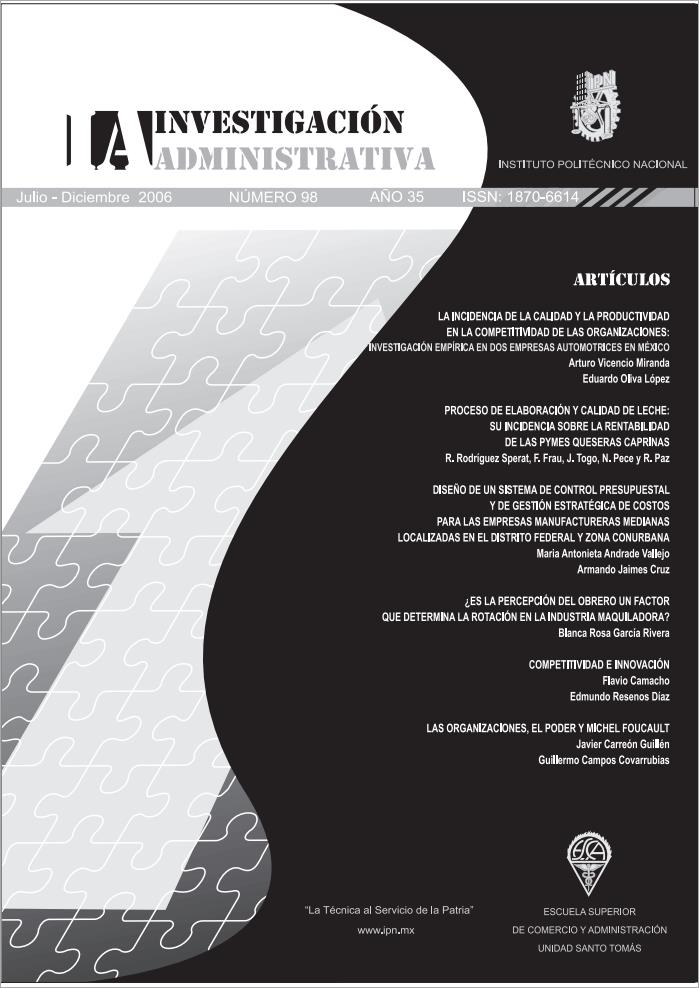OMPETITIVENESS AND INNOVATION
Main Article Content
Abstract
This paper aims in two objectives, first is to analyze the type of resources of an enterprise and how they are used in innovation, define it as the process of creation or improvement of products or processes with a lucrative end in such two phases are identified: creative one and executive one; and two ways of classifying innovation: first based on level of technological change and second based on product life cycle. Second objective is to analyze how the innovation has an effect over the increase of competitiveness; understood as the capacity of adding abilities, knowledge, effort, motivation and resources, all under the action of management reach a level of synergy that enterprise is placed in predetermined market position, defined in one of the four levels of competitiveness: surviving, growth, development or success.
Article Details

This work is licensed under a Creative Commons Attribution-NonCommercial 4.0 International License.
References
Campbell, R. (2000). “Architecting and Innovating”. Center for Innovation in Product Development, Massachusetts Institute of Technology.
Eppinger S. & Salminen V. (2001). “Patterns of Product Development Interactions”. International Conference of Engineering Design, Glasgow.
Henderson, R. (1990). “Architectural Innovation: The reconfiguration of existing product technologies and the failure of established firms”. Administrative Science Quaterly.
Holmes, M. & Campbell, R. (2002). “Product Development Processes Three Vectors of Improvement”. MIT, Massachusetts.
Kimbell, R. (2002). “Assessing design innovation”. Technology Education Research Unit, Goldsmiths University of London.
Kuniyoshi, (1988). “Innovation and the Japanese Management System”. Innovation & Management International Comparisons, Walter de Gruyter.
Martin, A. & Valdés, L. (2003, enero- marzo). “La innovación y el desarrollo tecnológico como una política de Estado y los estímulos fiscales para promoverla”. Contaduría y Administración, No. 208.
Moore, G. (2004, Agosto). “Innovar dentro de las empresas establecidas”. Hardvard Business Review.
Mouritsen, J. (2003). “Intellectual capital and the capital market: the circulability of intellectual capital”. Accounting, Auditing & Accountability Journal.
Piva, M. & Vivarelli, M. (2003). “Innovation and Employment evidence from Italian Microdata”, Institute for the study of labor, Bonn, Germany, Discussion paper 730.
Porter, M. (1987). “Ventaja Competitiva”, CECSA, 1 edición, México.
Porter, M. (2003). “Building the Microeconomic Foundations of Prosperity: Findings from the Business Competitiveness Index”. Chapter 1.2 Global Competitiveness Report, World Economic Forum.
Real Academia Española. (1992). “Diccionario de la Lengua Española”, ESPASA, 21a edición, Madrid.
Reiljan, J. & Hinrikus, M. & Ivanov, A. (2000). “Key Issues in Defining and Analysing the Competitiveness of a Country”. Faculty of Economics and Business Administration, University of Tartu Estonia.
Resnick, R, (2004). “Impersonal Sociotechnical Capital, ICT’s, and Collective Action among Strangers”.
Rivera, C. & Resenos, E. (1996). “Innovación Tecnológica, los Fines y las Estrategias Organizacionales”. Investigación Administrativa. Vol. 79.
Ross, G. (2003). “An Intellectual Capital Primer”. Centre for Business Performance, Cranfield University.
Ross, S. & Westerfield, R. & Jaffe, J. (2000). “Finanzas Corporativas”. Irwin McGraw- *73 Hill, 5a edición, México.
Twiss, B. (1980). “Managing Technological Innovation”. 2nd edition, Longman, G.B.
Wonglimppiyarat, F. (2004). “The use of strategies in managing technological innovation”, European Journal of Innovation Management, Vol. 7, No. 3.
Zambón, S. (2002). “Accounting, Intangibles and Intellectual Capital: an overview of the issues and some considerations”. Accounting, Audit, and Financial Analysis in the New Economy, University of Ferrara.

